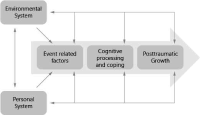
This study aimed to explore the types of traumatic event experienced by Volleyball players and then prepare to take-off the serial process of posttraumatic growth to schematize a causal network by organizing the factors for overcoming adversity. Participants experiences were collected by distributing open-ended questionnaires to 77 professional Women's volleyball players in 2013-2014 and collected data was categorized by inductive content analysis. These results were schematized by the causal network. As a result of the study, according to the trauma were categorized into four general areas: member conflict, competence loss, physical injury, and coach conflict and the emotions relative to the trauma were categorized into four general areas: powerlessness, pressure, dejection, and hostility also coping factors were categorized into three general areas: social support, intervention strategies, and psychological control. Finally, positive growth emerged as psychological leap, performance improvement, psychological maturity, and emotional stability. And as a result of the categorized study, bring about a better understanding to the posttraumatic growth by causal network. Based on the study results, that volleyball players experienced a positive development on themself after overcoming the problem that they had suffered psychological scars from a traumatic event. In doing so, they contributed to the formation of resources that helped them in their positive lives. In this regard, this study expects to provide the players who have been scratched in mind because of the traumatic experience.






[Purpose] This study attempted to provide a literature review of the research on posttraumatic growth and to propose a revised model which mainly explain the relationships among serious leisure, posttraumatic growth, health, and happiness. The concept of psychological growth following a traumatic life event is most commonly referred to as posttraumatic growth in the literature and was first coined by Tedeschi and Calhoun (1995). It can be postulated that such experiences can lead to a richer appreciation for life, more compassion for others, closer relationships with others, better understanding of one's potentials and possibilities, and stronger religious faith. [Methods] The purposes of this study were achieved by (1) reviewing the posttraumatic growth and its relationship to serious leisure; (2) analyzing recent posttraumatic growth related models; and (3) proposing a revised posttraumatic growth model and a research agenda to further progress posttraumatic growth research. [Conclusions] Although there is an abundance of evidence for the existence of posttraumatic growth, its nature as well as benefits in relation to participation in serious leisure remain very partially understood. This study proposes a revised model for understanding the process of porsttraumatic growth in which serious leisure and cognitive processing play a significant role. Important implications of the relationships between serious leisure and posttraumatic growth are mainly discussed, alongside recommendations for future research.


